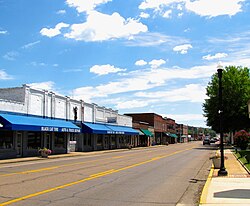Dunlap, Tennessee
| Dunlap, Tennessee | |
|---|---|
| City | |

Rankin Avenue (US-127) in Dunlap
|
|
 Location of Dunlap, Tennessee |
|
| Coordinates: 35°22′38″N 85°23′18″W / 35.37722°N 85.38833°WCoordinates: 35°22′38″N 85°23′18″W / 35.37722°N 85.38833°W | |
| Country | United States |
| State | Tennessee |
| County | Sequatchie |
| Founded | 1858 |
| Incorporated | 1901 |
| Named for | William Dunlap, state legislator |
| Area | |
| • Total | 8.6 sq mi (22.3 km2) |
| • Land | 8.6 sq mi (22.3 km2) |
| • Water | 0.0 sq mi (0.0 km2) |
| Elevation | 712 ft (217 m) |
| Population (2010) | |
| • Total | 4,815 |
| • Density | 484.2/sq mi (186.9/km2) |
| Time zone | Central (CST) (UTC-6) |
| • Summer (DST) | CDT (UTC-5) |
| ZIP code | 37327 |
| Area code(s) | 423 |
| FIPS code | 47-22000 |
| GNIS feature ID | 1283187 |
| Website | www |
Dunlap is a city in and the county seat of Sequatchie County, Tennessee, United States. The population was 4,173 at the 2000 census and 4,815 at the 2010 census.
Dunlap is part of the Chattanooga, TN–GA Metropolitan Statistical Area.
Dunlap was founded in 1858 as a county seat for Sequatchie County, which had been created the previous year. The city was named for state legislator William Dunlap, who played a prominent role in the county's creation. The city's initial 40 acres (0.16 km2), which were deeded to the county commissioners by Willam Rankin, were chosen due to their central location within the new county. Dunlap was incorporated as a city in 1941.
Around 1900, the Douglas Coal and Coke Company purchased 14,000 acres (57 km2) of land in the Dunlap vicinity with plans to mine coal and convert the coal into industrial coke. Coke, which is created by heating coal and removing its volatile matter, is used primarily as a deoxidizing agent in the production of pig iron. To convert coal mined on nearby Fredonia Mountain into coke, Douglas built the first of 268 ovens. The company used an incline railway to move the coal from the mountain to the ovens. Although Douglas went bankrupt in 1904, the Chattanooga Iron and Coal Company purchased the ovens, and continued producing coke until 1927. In the 1980s and 1990s, the Sequatchie Valley Historical Association acquired the ruins of the coke ovens and established Dunlap Coke Ovens Park.
Dunlap is located at 35°22′38″N 85°23′18″W / 35.37722°N 85.38833°W (35.377236, -85.388455). The city is located near the center of Sequatchie Valley, a narrow, 65-mile (105 km) long valley that slices through the Cumberland Plateau in southeastern Tennessee and northeastern Alabama. The plateau's western Sequatchie Valley escarpment, known locally as "Fredonia Mountain," rises over 1,000 feet (300 m) above the valley just west of Dunlap. The Sequatchie River forms the city's southeastern boundary.
...
Wikipedia
